skortaiw南海问题研究
南海实质问题与挑战感想
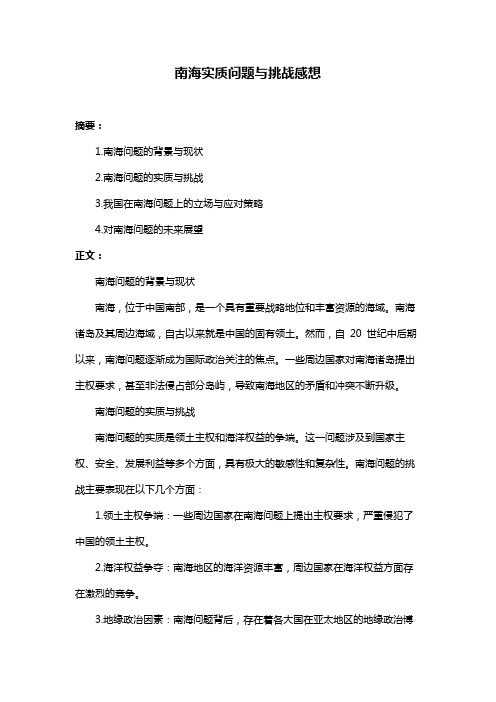
南海实质问题与挑战感想摘要:1.南海问题的背景与现状2.南海问题的实质与挑战3.我国在南海问题上的立场与应对策略4.对南海问题的未来展望正文:南海问题的背景与现状南海,位于中国南部,是一个具有重要战略地位和丰富资源的海域。
南海诸岛及其周边海域,自古以来就是中国的固有领土。
然而,自20 世纪中后期以来,南海问题逐渐成为国际政治关注的焦点。
一些周边国家对南海诸岛提出主权要求,甚至非法侵占部分岛屿,导致南海地区的矛盾和冲突不断升级。
南海问题的实质与挑战南海问题的实质是领土主权和海洋权益的争端。
这一问题涉及到国家主权、安全、发展利益等多个方面,具有极大的敏感性和复杂性。
南海问题的挑战主要表现在以下几个方面:1.领土主权争端:一些周边国家在南海问题上提出主权要求,严重侵犯了中国的领土主权。
2.海洋权益争夺:南海地区的海洋资源丰富,周边国家在海洋权益方面存在激烈的竞争。
3.地缘政治因素:南海问题背后,存在着各大国在亚太地区的地缘政治博弈。
4.军事安全风险:南海地区的矛盾和冲突,可能导致地区军事化,威胁到地区的和平与稳定。
我国在南海问题上的立场与应对策略我国在南海问题上的立场是一贯的、明确的,坚决维护国家的领土主权和海洋权益。
我国政府一直致力于通过外交途径解决南海问题,同时加强在南海地区的实际管控,采取多种措施捍卫国家利益。
1.坚定维护国家主权:我国政府坚决反对任何形式的领土主权侵犯行为,维护国家的领土完整。
2.加强外交努力:积极开展与有关国家的对话与合作,寻求通过和平谈判解决争端。
3.推动地区规则建设:积极参与南海地区的规则制定,推动建立公平、合理的地区秩序。
4.强化实际管控:加强在南海地区的军事、执法、科研等方面的存在,维护国家海洋权益。
对南海问题的未来展望南海问题短期内难以完全解决,但随着地区国家间合作不断加强,和平解决争端的基础将逐步巩固。
未来南海问题的解决,需要各方共同努力,秉持平等、互信、合作的原则,推动地区局势持续稳定。
南海问题浅析

应对南海问题南海是中国海域中面积最大的一个海,渤海、黄海、东海加在一起还不如南海大。
南海面积近360万平方公里。
世界上面积超过300万平方公里的海只有3个,南海排在南太平洋的珊瑚海和印度洋的阿拉伯海之后,是世界第三大海。
所谓南海问题,指的是南海周边的6国7方,即中国大陆和台湾、越南、马来西亚、印度尼西亚、文莱和菲律宾,在南海岛礁归属和海域划分上存在分歧和争端。
目前,我在南海面临的矛盾和挑战主要来自于三个方面:一是我海洋发展战略与南海主权争议久未解决之间的矛盾;二是我“搁置争议、共同开发”的政策与有关国家搁置中国、排斥中国开发之间的矛盾;三是我把南海问题留待未来解决的期待与各有关国家相继争夺资源、时不我待之间的矛盾。
中国政府一贯主张本着互谅互让的原则、以和平方式谈判解决国际争端。
根据这一精神,中国已同绝大多数的陆地邻国通过双边协商和谈判,公正、合理、友好地解决了领土边界问题。
这一立场同样适用于南海。
中国是政治大国,但还不是强国。
中国崛起所遇到的阻力和困难远比我们想象的要复杂。
大国的遏制乃至围堵,一些中小国家的戒备和防范,都给我和平解决海洋权益之争带来了负面影响。
但这并不等于说中国在南海问题上应持消极等待或无动于衷的态度。
基于中华民族的民族性格和爱好和平的传统,在建设和谐社会和构建和谐世界的大背景下,中国处理南海问题的思维取向一定是冷静、和平、友好的,而不是锋芒毕露、穷兵黩武的。
现今中国需要的南海,是和平的南海而不是战争的南海。
但善良的愿望不能被某些国家所利用,友好的政策不能成为一些国家得寸进尺的机会或工具。
为此,在维护南海主权权益问题上也需要采取一些新思维和举措。
解决南海问题首先是要强化主权观念和主权行为,并加强有关立法。
“主权属我”应作为“共同开发”的前提条件。
没有“主权属我”的前提,就很难“搁置争议”,“共同开发”的目标也无法真正实现。
其次是加快我国领海基线勘定。
这对我与其他国家的交涉以及增加谈判桌上讨价还价的筹码至关重要。
文档我国南海问题的影响因素及对策研究

引言所谓“南海问题”,指的是南海周边的国家在南海各岛礁沙滩的归属以及海域划分问题上存在的分歧与争端。
南海问题的症结,是中国由于受到国际环境的限制、对外战略轻重缓急权衡以及自身力量的制约,而不能完全行使对南海诸岛的主权。
自古以来南海诸岛就是中国领土神圣不可分割的一部分。
随着经济全球化的浪潮,各国间的经济往来越为密切,彼此的经济依存度越来越高,各国间的竞争是凭借各自的经济实力为基础的综合实力的竞争,然而经济的发展必须依靠资源,这时南海丰富的资源就很快就成为南海问题产生的导火索,再者南海的地理位置相当特殊,具有重要的战略意义,正因为如此,南海来成为了周边各国争夺的对象。
自20世纪90年代以来,南海问题变得更为复杂,南海周边国家加紧了对南海诸岛的侵略,区域外大国又加紧对南海事务的渗透,南海问题已趋于国际化。
中国历来是个追求和平的国家,面对目前复杂的南海问题,中国提出了“搁置争议,共同开发”的主张,成为中国从90年代以来解决南海问题的主要原则。
“搁置争议,共同开发”原则从提出到现在已有二十多年,其所带来的现实成效是双方面的。
一方面,中国政府在提出“搁置争议,共同开发”这一原则时只说了是暂且搁置南海问题,但并没有具体指出要暂且搁置到什么时候,而且也没有对共同开发做个详细的规划,同时南海问题的各争端方对“搁置争议,共同开发”这一主张也持有怀疑态度,但必须看到,中国这一倡议的确在一定程度上缓解了中国与南海周边国家的紧张关系。
例如菲律宾为了加强地区团结,于20世纪60年代放弃了对巴的声称,甚至越南也和东盟大多数国家成员国达成和解,中国到目前为止还一直在进行着共同开发的外交努力。
而且从最近的发展也可以看出,世界各地都对“主权属我,搁置争议,共同开发”这一原则表示认可,说明“搁置争议,共同开发’’这一原则具有一定的优越性,比如促进边界争端的解决、保证共同使用资源的公平分配、避免因领土争端造成的潜在冲突逐步升级;另一方面,“搁置争议,共同开发”原则具有一定局限性。
南海局势研究报告

南海局势研究报告近年来,关于南海问题,中国与部分东南亚地区国家一直争论不休。
所谓的南海问题,就是南海周围国家对南海的主权归属及资源开发的争议。
这已经成为了全世界关注的焦点。
我也就此做了相应的调查。
我主要通过看新闻联播、上网查资料、询问父母的方法,得出了以下结论。
南海地区地处热带,渔业资源丰富,富含还早、海带等热带资源,及海洋能源,其中还包括了丰富的石油天然气资源。
估计总储量将近二百亿吨,是世界上尚待开发的大型油藏之一,其中有一半以上储量分布在中国海域。
南海具有如此丰富的资源,必将成为周围诸国争抢的目标。
然而,南海自古以来就是中国圣神不可分割的领土。
外交部多次宣称:“中国对南沙群岛和附近海域拥有主权的历史和法理依据在于,中国最早发现并命名南海诸岛,最早并持续对南海诸岛行使主权。
中国早在汉代就发现了南沙群岛,唐代以来的历代政府一直对南沙群岛进行管辖。
1949年,中华人民共和国成立后,继续行使对南沙群岛的主权。
中国在南海的主权、权利以及相关主张一直为中国政府所坚持。
”但近年来,周边国家频繁进入我国领土,盗窃我国的大量资源,还请西方国家入驻及勘探,造成大量经济损失。
比如越南在我国的经济专属区和大陆架,中国在发现后及时派遣海监船剪短了探们的勘测电缆,而越南政府却胡乱指责中国海监船侵犯越南领海进行破坏、阻挡PVN正常勘探活动,是极为霸道的行为,大肆侵犯越南领海主权权利,同时给PVN造成巨大的经济损失和影响PVN的正常活动。
这是十分令人气愤和无耻的。
事后越南首都河内12日爆发连续两天的反中国示威游行。
游行者将近200人,他们挥舞越南国旗和反华标语,高唱爱国歌曲并高呼“打倒中国”和“长沙群岛(即中国的南沙群岛)和黄沙群岛(中国称西沙群岛)是越南领海”的口号。
这都是因为政府的行动造成的,越南政府应该好好反思。
如今,这样的事件还有许多,我衷心希望南海问题有一个和平、有好的解决方式。
浅谈南海问题的原因及其应对策略论文2000字
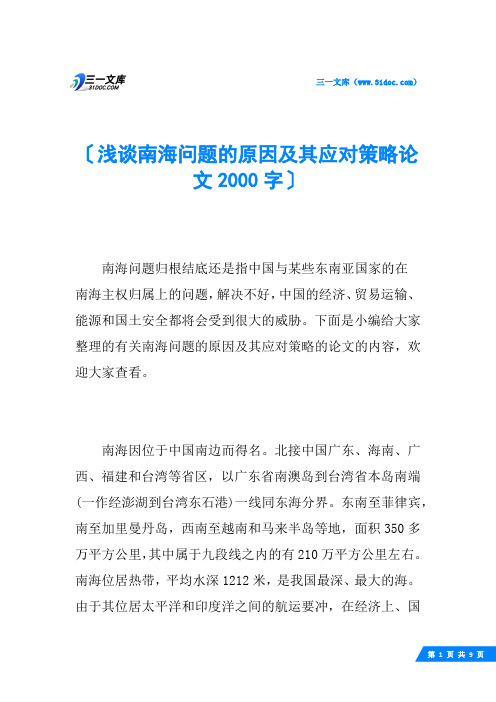
三一文库()〔浅谈南海问题的原因及其应对策略论文2000字〕南海问题归根结底还是指中国与某些东南亚国家的在南海主权归属上的问题,解决不好,中国的经济、贸易运输、能源和国土安全都将会受到很大的威胁。
下面是小编给大家整理的有关南海问题的原因及其应对策略的论文的内容,欢迎大家查看。
南海因位于中国南边而得名。
北接中国广东、海南、广西、福建和台湾等省区,以广东省南澳岛到台湾省本岛南端(一作经澎湖到台湾东石港)一线同东海分界。
东南至菲律宾,南至加里曼丹岛,西南至越南和马来半岛等地,面积350多万平方公里,其中属于九段线之内的有210万平方公里左右。
南海位居热带,平均水深1212米,是我国最深、最大的海。
由于其位居太平洋和印度洋之间的航运要冲,在经济上、国防上都具有重要的意义。
早在元朝时期,南海就已经划入中国版图。
20世纪中期以前,中国(包括清政府、中华民国、中华人民共和国等政权)一直声称拥有南海的主权,而且没有引起过其他国家的争议。
20世纪60年代,南海海底勘探出大量的石油天然气资源,从此围绕南海海域及岛屿的主权争议,成了亚洲最具潜在危险性的冲突点之一。
从70年代起,菲律宾、越南、马来西亚、开始占岛。
80年代,印度尼西亚、文莱也趁火打劫,混水摸鱼,向我国南海提出领土要求,并利用东盟组织联合起来向我国政府施加压力,促使南沙群岛国际化,使我国南海及南沙群岛问题的解决越来越困难,越来越被动。
南海尤其是南沙群岛大量岛屿被占。
而1982年联合国第三次海洋法会议上获得通过的《联合国海洋法公约》更加刺激了这些国家对南海诸岛的分割占领。
中国的海洋领土和海洋权益受到了前所未有的威胁和挑战。
本无争议的南沙群岛为何会形成主权争议如此复杂的南海问题呢?原因有三:其一,就是其本身重要的战略地位和丰富的自然资源。
南海位居太平洋和印度洋、亚洲和澳洲来往的“十字路口”,自古就是著名的海上的“丝绸之路”。
国际上一直有观点认为,谁控制了南海,谁就控制了东南亚,从而控制了西北太平洋和澳洲大陆。
南海争端问题的研究

南海争端问题的研究前言南沙群岛,中国早在公元前两世纪的汉武帝时代发现并命名该群岛,并在1621年刊印的《郑和航海图》将其列入中国版图。
南沙群岛;《开罗宣言》和《波茨坦公告》及其他国际文件明确规定把被日本窃取的中国领土归还中国,这自然包括了南沙群岛。
1946年12月,当时的中国政府指派高级官员赴南沙群岛接收,在岛上举行接收仪式,派兵驻守。
日本政府于1952年正式表示放弃对台湾、澎湖列岛以及南沙群岛、西沙群岛之一切权利、权利名义与要求,从而将南沙群岛正式交还给中国。
所以自古以来就是中国的固有领土,这是无可争议的事实。
而南海问题的研究有助于我们在正确处理国家与国家之间的领土争议问题中起借鉴作用,为国家正确解决南海问题提出意见与建议。
目录1、源2、发展3、立场、主张4、历、法依据5、美丽的南海6、问卷调查一、源南沙群岛早在汉朝汉武帝时期被发现!到了隋朝,地图上就可看见南海全图。
由于汉末到隋初,战乱300多年,有些中国人为了躲避战乱,出海南海诸国和东南亚等地,隋统一后成为中国一部分。
《隋书》记载,公元607年,“(常)骏等自南海郡乘舟,昼夜二旬,每值便风,至焦石山,而过东南,泊陵伽钵拔多洲,西与林邑相对,上有神祠焉。
”其中记载的“焦石山”即礁石,从航程来看确指西沙群岛。
唐代杜佑所著《通典》也有大致相同的记载,同样以“焦石山”指称西沙群岛。
二战中日本占领我国大部分地区包括南沙群岛,而后在《开罗宣言》和《波茨坦公告》及其他国际文件明确规定把被日本窃取的中国领土归还中国,这自然包括了南沙群岛。
1946年12月,当时的中国政府指派高级官员赴南沙群岛接收,在岛上举行接收仪式,并立碑纪念,派兵驻守。
日本政府于1952年正式表示放弃对台湾、澎湖列岛以及南沙群岛、西沙群岛之一切权利、权利名义与要求,从而将南沙群岛正式交还给中国。
由此正式确定中国对南沙群岛的主权。
本无争议的属于中国领土的南沙群岛为何会形成主权争议导致如此复杂的南海问题呢?原因有二:其一,其本身具有重要的战略地位和丰富的自然资源南海位居太平洋和印度洋、亚洲和澳洲来往的“十字路口”,自古就是著名的海上“丝绸之路”、“陶瓷之路”。
南海问题论文 (4)

南海问题论文引言南海问题作为东南亚地区的一大热点问题,近年来备受关注。
南海是一个地理位置重要的海域,拥有丰富的自然资源和战略位置,因此成为多个国家之间的争议焦点。
本论文旨在探讨南海问题的背景、产生原因以及各方的立场和解决途径,以期对南海问题有更全面的了解。
背景南海是太平洋西南部的一个海域,位于中国大陆东南沿海,面积约360万平方公里,涵盖了众多岛屿、礁石和浅滩。
南海地区被誉为世界各大海洋中最为重要的海域之一,其拥有丰富的石油、天然气、鱼类资源以及重要的海上航道。
然而,南海问题的产生源于对领土主权、海洋划界和资源开发权的争议。
产生原因南海问题的产生原因复杂多样,涉及历史、法律和利益等诸多因素。
以下是几个主要的产生原因:1.历史因素:南海地区古代中国和其他周边国家的海上活动长期存在,并形成了一些历史性的争议。
不同国家对南海地区的历史纪录和定居点有不同的解读和主张,导致争议的继续存在。
2.领土主权争议:南海地区涉及涵盖了多个岛屿和岛礁,这些岛屿被多个国家声称拥有领土主权。
其中最著名的争议岛屿包括中国的南沙群岛、西沙群岛,越南的西沙群岛和东沙群岛,菲律宾的南沙群岛等。
3.海洋划界问题:南海地区的国家之间还存在着海洋划界问题,即如何划定各国的专属经济区和大陆架。
各国根据不同的法律和国际公约提出了不同的划界主张,导致了争议的产生。
4.利益驱动:南海地区的资源开发潜力巨大,其中包括丰富的石油、天然气和渔业资源等。
各国在南海地区的资源探测、开发和利用上存在着利益的争夺。
各方立场南海问题涉及多个国家,每个国家都有自己的立场和主张。
以下是几个主要方的立场:1.中国:中国坚持自己拥有南海绝大部分岛屿的主权,并主张根据历史事实和国际法原则划定海洋划界。
中国主张通过对话和合作解决南海争议,坚决反对任何一国在南海地区的军事化行动。
2.越南:越南对南海地区拥有的岛屿主权主张与中国存在重叠,因此与中国之间存在比较激烈的争议。
越南主张通过国际法解决南海争议,反对任何一国在南海地区扩大势力和军事化。
南海争端问题研究

二、历史由来
南海群岛最早由中国人发现并经营
东汉杨孚的《异物志》记录南海“涨海崎头,水 浅而多磁石”。三国东吴将领康泰在《扶南传》 提到南沙群岛,并对南沙群岛的形态做了各种描 述。 《元史》、《地理志》、《元代疆域图序》都记 载了元代疆域包括了南沙群岛,对南沙群岛行使 管辖权。《元史》记载了元朝海军巡查南沙群。 明、清时代,南海群岛划归琼州府万州管辖,并 列入我国版图,从此成为我国领土不可分割的一 个组成部分。 第二次世界大战中,南海群岛在1939年被日本所 侵占。
南海各国主张的海疆线
美国
重返亚太: 一是上门挑唆。
二是恩威相挟。 三是舆论渲染。 四是军事操纵。
美“乔治· 华盛顿”号航空母舰 2011年8月抵达越南访问。
美国南海声明
美国国务院代理副发言人帕特里克· 文特瑞尔8月3日就中国 南海问题发表声明,声明指责中国进一步加剧南海地区紧 张局势。 声明说,美国对南海局势紧张升级表示关切,正在对形势 发展密切跟踪。近来局势发展中对抗性言论、资源开发分 歧、胁迫性经济行动、包括使用障碍物阻止进入黄岩岛周 边事件不断升级,特别是中国提升三沙市行政级别,在南 海有争议地区建立一个新的警备区之举有违通过外交合作 解决分歧,进一步加剧地区紧张局势升级风险。 声明说,美国在南海领土争端中不选边站队,也没有领土 野心,但美国相信该地区国家应通过合作及外交努力解决 分歧,而不应强迫、恫吓、威胁和使用武力。 声明说,为建立和平解决分歧的清晰程序规则,美国鼓励 东盟国家与中国就最终完成南海行为准则取得有意义的进 展。在此背景下,美国支持东盟最近就南海问题达成的六 点原则。
中国台湾
台湾当局认为,南沙和西沙群岛与东沙、中沙群 岛一并,自古以来属于“中华民国”领土。 1974年大陆在西沙进行对越自卫反击战时,台湾 军方开放封锁近30年的台湾海峡,帮助东海舰队 军舰开赴战场;1988年,中越在赤瓜礁发生冲突, 南海舰队经台方默许在太平岛停留一星期并进行 物资补给。 台湾当局对目前与大陆就南海问题进行合作持 “比较顾虑的态度”,主要因为美国、日本和东 盟国家担心两岸联手与之对抗;而台湾在军事、 政治、经济关系上相当依赖美国、日本,也希望 拓展与东南亚国家的双边关系。
南海问题调查报告

南海问题调查报告南海问题调查报告一、引言南海问题一直以来都是国际社会关注的焦点之一。
作为一个拥有丰富资源和战略地位的海域,南海的争端牵动着多个国家的利益。
为了深入了解南海问题的来龙去脉以及各方立场和主张,本文将对南海问题进行调查报告。
二、南海地理背景南海位于东南亚地区,被中国、越南、菲律宾、马来西亚、印度尼西亚和文莱等多个国家所声索。
南海拥有丰富的石油、天然气和渔业资源,同时也是重要的航运通道。
这使得南海成为了争议的焦点。
三、历史背景南海争端的根源可以追溯到19世纪末的殖民时期。
当时,西方列强开始在南海地区进行势力范围的划分,并侵占了许多岛屿和海域。
这些行为为后来的争端埋下了伏笔。
四、各方主张1. 中国立场中国主张南海拥有主权,并以历史事实和国际法为依据。
中国声称拥有南海诸岛及其附属岛屿的主权,并坚决反对外部势力干涉南海问题。
2. 越南立场越南也声称拥有南海的主权,并以历史事实为依据。
越南认为自己对南海的主张得到了国际法的支持,并强调应通过对话和谈判解决争端。
3. 菲律宾立场菲律宾声称拥有南海的主权,并以国际法为依据。
菲律宾提起了对中国的仲裁案,并在2016年获得了一定胜利。
菲律宾主张通过国际法解决争端。
4. 马来西亚和印度尼西亚立场马来西亚和印度尼西亚对南海问题持中立立场。
他们主张通过对话和谈判解决争端,并呼吁各方保持克制。
五、国际社会关注和介入南海问题不仅仅是争端各方之间的问题,也引起了国际社会的广泛关注。
美国、日本等国家对南海问题持有立场,并通过军事行动和外交斡旋来影响局势。
其他国家和地区也对南海问题表达了关切,并呼吁各方保持克制和通过对话解决争端。
六、解决途径南海问题的解决需要各方的共同努力和妥协。
以下是一些可能的解决途径:1. 对话和谈判:各方应通过对话和谈判解决争端,尊重国际法和国际准则。
2. 国际仲裁:有争议的各方可以通过国际仲裁来解决争端,接受国际法的裁决。
3. 合作共赢:各方可以通过共同开发南海资源、合作打击非法渔业和保护环境等方式,实现互利共赢。
俄国黑海战略对中国南海战略的启示
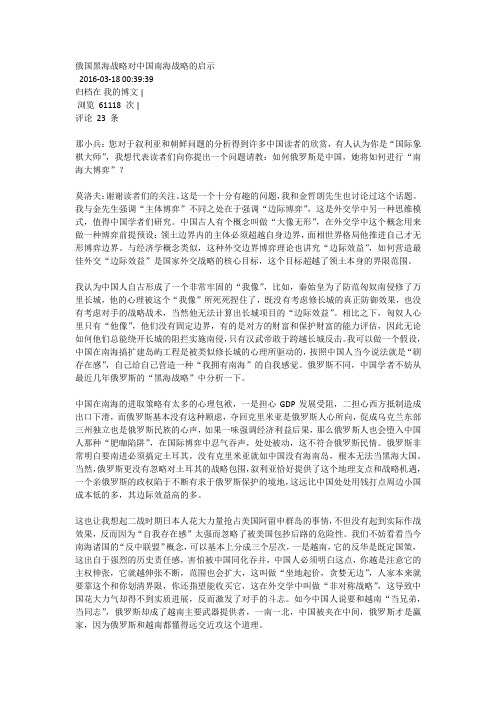
俄国黑海战略对中国南海战略的启示2016-03-18 00:39:39归档在我的博文 |浏览61118 次 |评论23 条那小兵:您对于叙利亚和朝鲜问题的分析得到许多中国读者的欣赏,有人认为你是“国际象棋大师”,我想代表读者们向你提出一个问题请教:如何俄罗斯是中国,她将如何进行“南海大博弈”?莫洛夫:谢谢读者们的关注。
这是一个十分有趣的问题,我和金哲朗先生也讨论过这个话题。
我与金先生强调“主体博弈”不同之处在于强调“边际博弈”,这是外交学中另一种思维模式,值得中国学者们研究。
中国古人有个概念叫做“大像无形”,在外交学中这个概念用来做一种博弈前提预设:领土边界内的主体必须超越自身边界,面相世界格局他推进自己才无形博弈边界。
与经济学概念类似,这种外交边界博弈理论也讲究“边际效益”,如何营造最佳外交“边际效益”是国家外交战略的核心目标,这个目标超越了领土本身的界限范围。
我认为中国人自古形成了一个非常牢固的“我像”,比如,秦始皇为了防范匈奴南侵修了万里长城,他的心理被这个“我像”所死死捏住了,既没有考虑修长城的真正防御效果,也没有考虑对手的战略战术,当然他无法计算出长城项目的“边际效益”。
相比之下,匈奴人心里只有“他像”,他们没有固定边界,有的是对方的财富和保护财富的能力评估,因此无论如何他们总能绕开长城的阻拦实施南侵,只有汉武帝敢于跨越长城反击。
我可以做一个假设,中国在南海搞扩建岛屿工程是被类似修长城的心理所驱动的,按照中国人当今说法就是“刷存在感”,自己给自己营造一种“我拥有南海”的自我感觉。
俄罗斯不同,中国学者不妨从最近几年俄罗斯的“黑海战略”中分析一下。
中国在南海的进取策略有太多的心理包袱,一是担心GDP发展受阻,二担心西方抵制造成出口下滑,而俄罗斯基本没有这种顾虑,夺回克里米亚是俄罗斯人心所向,促成乌克兰东部三州独立也是俄罗斯民族的心声,如果一味强调经济利益后果,那么俄罗斯人也会堕入中国人那种“肥咖陷阱”,在国际博弈中忍气吞声,处处被动,这不符合俄罗斯民情。
南海问题分析

1、中国拥有南海主权的法理基础。
在国际法上,“有效占领”是一个国家有意识地取得当时不在任何国家主权之下的土地主权的一种占取行为。
在依据该原则取得某一土地主权时,有些条件必须得到满足:被占领土地此前必须是无主地,在对无主地“发现”和“先占”后,对该土地要进行必要的主权行使和管辖,当然也包括一国政府和人民对该土地的开发与经营。
中国对南沙群岛拥有“发现”权南海诸岛在被中国发现以前,尚属于“无主地”,中国对南海诸岛的领土主权,是在漫长的历史中逐渐形成和完善的。
早在汉代之时,中国人就已开始在南海航行。
经过长期的航海实践,中国人先后发现了西沙、南沙群岛。
宋时,中国人把包括南沙群岛在内的南海诸岛命名为“长沙”、“石塘”。
明清时,南海诸岛被标示在中国官方的地图中,并且标出了南海航线和航程。
尽管“发现”并不构成通过先占取得领土,但它的重要性不容抹煞。
“发现”给予发现国以“初步”的权利或“不完整”的权利。
发现国在合理期间行使“有效占领”前,这种权利有暂时阻止他国加以占领的作用。
德国法学家奥本海对于领土取得方式在15、16世纪以前,与18、19世纪以后的差别作了明确的区分。
他指出,在15、16世纪以前,单纯的“发现”而无需任何其他行为,就可以取得对无主土地的完整主权。
英国学者布列尼也直言不讳地指出,在15、16世纪,单单是“发现”,而不需要采取任何进一步的实际行动,就可以取得对所发现土地的完整主权。
国际法学界关于“发现”的论述,不容否认地成为中国解决南海问题,尤其是南沙争端的重要法律依据。
从“先占”原则看中国对南沙群岛的主权根据国际法,一国基于对无主土地的“发现”可以进行“先占”。
“先占”是一国对“无主地”进行有效占领从而取得领土的方式之一。
此外,“先占”还必须具备如下几个条件:占有必须在一国主权权利中行使,必须存在对一国权利的显示和缺少对另一国主权的承认;占有必须是和平且无间断的;占有必须是公开的。
许多国际权威公法学家认为,并不是在所有的情况下,这些条件都是基本具备的。
南海问题分析
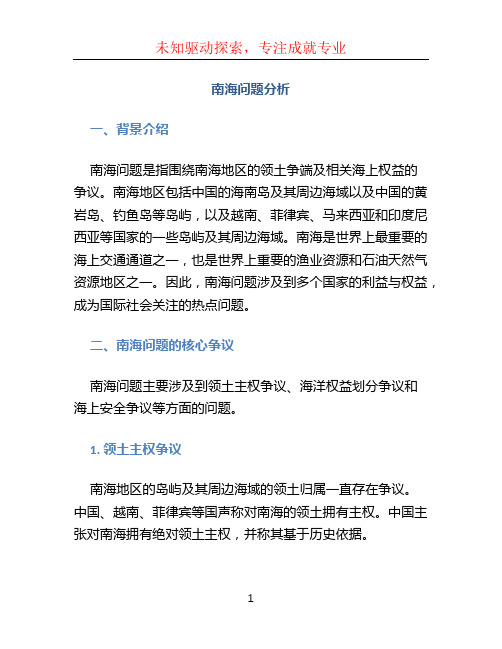
南海问题分析一、背景介绍南海问题是指围绕南海地区的领土争端及相关海上权益的争议。
南海地区包括中国的海南岛及其周边海域以及中国的黄岩岛、钓鱼岛等岛屿,以及越南、菲律宾、马来西亚和印度尼西亚等国家的一些岛屿及其周边海域。
南海是世界上最重要的海上交通通道之一,也是世界上重要的渔业资源和石油天然气资源地区之一。
因此,南海问题涉及到多个国家的利益与权益,成为国际社会关注的热点问题。
二、南海问题的核心争议南海问题主要涉及到领土主权争议、海洋权益划分争议和海上安全争议等方面的问题。
1. 领土主权争议南海地区的岛屿及其周边海域的领土归属一直存在争议。
中国、越南、菲律宾等国声称对南海的领土拥有主权。
中国主张对南海拥有绝对领土主权,并称其基于历史依据。
2. 海洋权益划分争议南海地区的海洋权益划分争议主要涉及到领海、专属经济区和大陆架的划分。
根据《联合国海洋法公约》,国家可以划定自己的领海、专属经济区和大陆架。
但是,南海地区涉及多个国家,各国之间的划界存在争议。
3. 海上安全争议南海地区的海上安全问题也是南海问题的主要争议之一。
南海地区经常发生渔船冲突、海上巡逻舰艇相遇、军事演习等事件,这些事件涉及到各国的海上安全利益和领土主权争议,容易导致紧张局势的升级和冲突的发生。
三、各方立场和解决途径1. 中国立场中国坚决主张对南海的领土主权,认为南海问题是中国内政问题,不愿通过国际仲裁解决。
中国提出通过友好协商划定海洋权益的方案,主张各方进行合作、共同开发南海资源。
2. 越南立场越南主张对南海的领土主权,与中国的主张存在冲突。
越南主张通过国际法和国际仲裁解决南海争议,并呼吁国际社会介入南海问题。
3. 菲律宾立场菲律宾也声称对南海的领土主权,并将南海争议提交到国际法庭仲裁。
菲律宾主张通过法律手段解决南海争议,并呼吁国际社会支持他们的诉求。
4. 解决途径针对南海问题,可以通过双边对话、多边谈判和国际仲裁等方式来解决。
同时,各方应充分尊重国际法和国际公约,坚持通过和平手段解决争议。
南海问题论文(1)
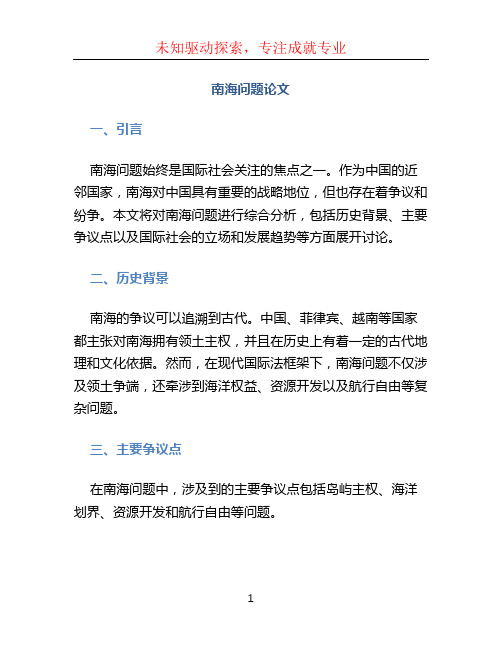
南海问题论文一、引言南海问题始终是国际社会关注的焦点之一。
作为中国的近邻国家,南海对中国具有重要的战略地位,但也存在着争议和纷争。
本文将对南海问题进行综合分析,包括历史背景、主要争议点以及国际社会的立场和发展趋势等方面展开讨论。
二、历史背景南海的争议可以追溯到古代。
中国、菲律宾、越南等国家都主张对南海拥有领土主权,并且在历史上有着一定的古代地理和文化依据。
然而,在现代国际法框架下,南海问题不仅涉及领土争端,还牵涉到海洋权益、资源开发以及航行自由等复杂问题。
三、主要争议点在南海问题中,涉及到的主要争议点包括岛屿主权、海洋划界、资源开发和航行自由等问题。
1. 岛屿主权南海拥有许多岛屿,其中一些岛屿被中国、菲律宾、越南等国家主张拥有主权。
这些岛屿主权的争议是南海问题的核心,不同国家在岛屿主权问题上持不同立场。
2. 海洋划界南海的海域划界问题涉及到各国的海洋权益。
根据国际法,沿岸国家有权划定专属经济区和大陆架。
然而,在南海问题中,各国在划界问题上存在分歧和争议。
3. 资源开发南海地区拥有丰富的资源,包括石油、天然气和渔业资源等。
各国都希望能够获得在南海的资源开发权。
然而,由于存在岛屿主权和海洋划界等问题,资源开发成为南海问题中的另一个主要争议点。
4. 航行自由南海是世界上重要的航道之一,航行自由是国际社会普遍认可的原则。
然而,在南海问题中,与航行自由有关的争议也屡屡出现。
有国家主张在南海设立航行限制区或引入更严格的船舶审查制度,这引发了国际社会的关注和争议。
四、国际社会的立场对于南海问题,国际社会的立场各不相同。
一方面,有国家支持中国主张的岛屿主权和海洋权益,认为中国有权在南海进行资源开发和维护航行自由。
另一方面,也有一些国家支持菲律宾、越南等国家的主张,认为他们在南海拥有合法的权益。
国际社会普遍呼吁各方通过对话和谈判解决南海争议,遵守国际法和国际社会普遍认可的原则,维护地区的和平与稳定。
五、发展趋势南海问题的发展趋势仍然不确定。
南海问题面临的挑战与应对思考论文2000字
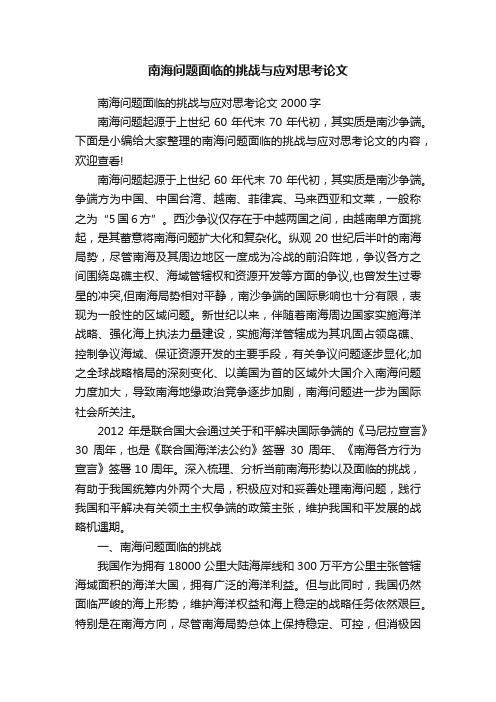
南海问题面临的挑战与应对思考论文南海问题面临的挑战与应对思考论文2000字南海问题起源于上世纪60年代末70年代初,其实质是南沙争端。
下面是小编给大家整理的南海问题面临的挑战与应对思考论文的内容,欢迎查看!南海问题起源于上世纪60年代末70年代初,其实质是南沙争端。
争端方为中国、中国台湾、越南、菲律宾、马来西亚和文莱,一般称之为“5国6方”。
西沙争议仅存在于中越两国之间,由越南单方面挑起,是其蓄意将南海问题扩大化和复杂化。
纵观20世纪后半叶的南海局势,尽管南海及其周边地区一度成为冷战的前沿阵地,争议各方之间围绕岛礁主权、海域管辖权和资源开发等方面的争议,也曾发生过零星的冲突,但南海局势相对平静,南沙争端的国际影响也十分有限,表现为一般性的区域问题。
新世纪以来,伴随着南海周边国家实施海洋战略、强化海上执法力量建设,实施海洋管辖成为其巩固占领岛礁、控制争议海域、保证资源开发的主要手段,有关争议问题逐步显化;加之全球战略格局的深刻变化、以美国为首的区域外大国介入南海问题力度加大,导致南海地缘政治竞争逐步加剧,南海问题进一步为国际社会所关注。
2012年是联合国大会通过关于和平解决国际争端的《马尼拉宣言》30周年,也是《联合国海洋法公约》签署30周年、《南海各方行为宣言》签署10周年。
深入梳理、分析当前南海形势以及面临的挑战,有助于我国统筹内外两个大局,积极应对和妥善处理南海问题,践行我国和平解决有关领土主权争端的政策主张,维护我国和平发展的战略机遇期。
一、南海问题面临的挑战我国作为拥有18000公里大陆海岸线和300万平方公里主张管辖海域面积的海洋大国,拥有广泛的海洋利益。
但与此同时,我国仍然面临严峻的海上形势,维护海洋权益和海上稳定的战略任务依然艰巨。
特别是在南海方向,尽管南海局势总体上保持稳定、可控,但消极因素和不稳定因素增多,南海问题的复杂性和艰巨性进一步凸显,维护南海和平稳定大局面临新的巨大挑战。
南海问题出现的原因分析及其应对策略
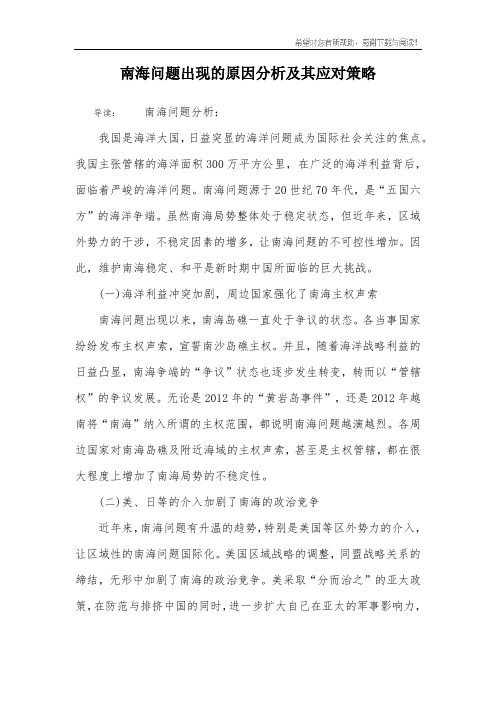
南海问题出现的原因分析及其应对策略导读:南海问题分析:我国是海洋大国,日益突显的海洋问题成为国际社会关注的焦点。
我国主张管辖的海洋面积300万平方公里,在广泛的海洋利益背后,面临着严峻的海洋问题。
南海问题源于20世纪70年代,是“五国六方”的海洋争端。
虽然南海局势整体处于稳定状态,但近年来,区域外势力的干涉,不稳定因素的增多,让南海问题的不可控性增加。
因此,维护南海稳定、和平是新时期中国所面临的巨大挑战。
(一)海洋利益冲突加剧,周边国家强化了南海主权声索南海问题出现以来,南海岛礁一直处于争议的状态。
各当事国家纷纷发布主权声索,宣誓南沙岛礁主权。
并且,随着海洋战略利益的日益凸显,南海争端的“争议”状态也逐步发生转变,转而以“管辖权”的争议发展。
无论是2012年的“黄岩岛事件”,还是2012年越南将“南海”纳入所谓的主权范围,都说明南海问题越演越烈。
各周边国家对南海岛礁及附近海域的主权声索,甚至是主权管辖,都在很大程度上增加了南海局势的不稳定性。
(二)美、日等的介入加剧了南海的政治竞争近年来,南海问题有升温的趋势,特别是美国等区外势力的介入,让区域性的南海问题国际化。
美国区域战略的调整,同盟战略关系的缔结,无形中加剧了南海的政治竞争。
美采取“分而治之”的亚太政策,在防范与排挤中国的同时,进一步扩大自己在亚太的军事影响力,进而使南海问题成为牵制并制约中国和平、稳定发展的重要“抓手”。
到2020年,美国60%的军力将部署于亚太地区,通过与菲律宾、越南以及新加坡等国家形成战略合作关系,部署前沿军事,进而对中国形成包围的政治态势。
(三)南海问题国际化、多边化,不稳定局势加剧南海问题国家化、多边化是新时期南海问题的发展趋势,特别是菲律宾、越南等国试图依托“东盟”,实现对南海主权的声索,进而形成“东盟一体化”,对中国实行牵制。
菲律宾、越南等国通过与区域外的大国建立多边协商机制,将南海问题推向国际化,从而借助区域外大国的力量,与中国进行抗衡,进而获取所谓的“主权”。
南海问题解决方案研究综述
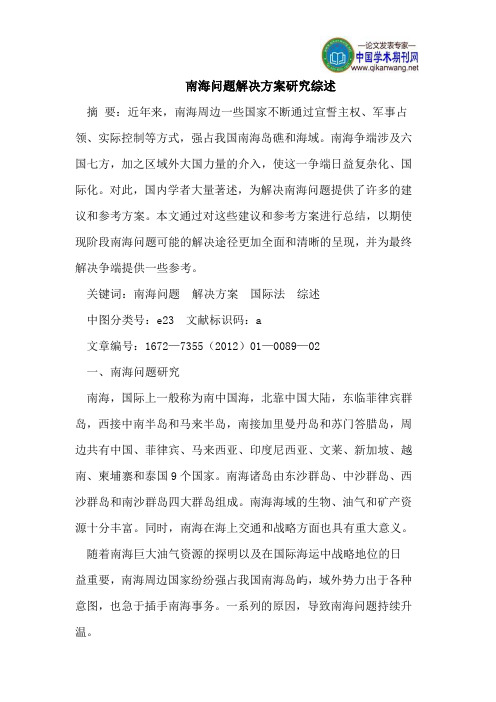
南海问题解决方案研究综述摘要:近年来,南海周边一些国家不断通过宣誓主权、军事占领、实际控制等方式,强占我国南海岛礁和海域。
南海争端涉及六国七方,加之区域外大国力量的介入,使这一争端日益复杂化、国际化。
对此,国内学者大量著述,为解决南海问题提供了许多的建议和参考方案。
本文通过对这些建议和参考方案进行总结,以期使现阶段南海问题可能的解决途径更加全面和清晰的呈现,并为最终解决争端提供一些参考。
关键词:南海问题解决方案国际法综述中图分类号:e23 文献标识码:a文章编号:1672—7355(2012)01—0089—02一、南海问题研究南海,国际上一般称为南中国海,北靠中国大陆,东临菲律宾群岛,西接中南半岛和马来半岛,南接加里曼丹岛和苏门答腊岛,周边共有中国、菲律宾、马来西亚、印度尼西亚、文莱、新加坡、越南、柬埔寨和泰国9个国家。
南海诸岛由东沙群岛、中沙群岛、西沙群岛和南沙群岛四大群岛组成。
南海海域的生物、油气和矿产资源十分丰富。
同时,南海在海上交通和战略方面也具有重大意义。
随着南海巨大油气资源的探明以及在国际海运中战略地位的日益重要,南海周边国家纷纷强占我国南海岛屿,域外势力出于各种意图,也急于插手南海事务。
一系列的原因,导致南海问题持续升温。
根据国际法的原则以及相关规定,发现和占领是取得领土的有效方式之一。
南海诸岛是中国人最早发现、最早命名、最早开发经营和管辖的海岛,这构成了法理上的有效占有,因而中国当然地拥有南海诸岛及其特定海域的主权。
南沙群岛自古以来就是中国领土,这是有古今中外的大量文献可资佐证的,已故的南海问题专家韩振华先生的著作《南海诸岛史地研究》是这一领域的代表作。
中国社会科学院中国边疆史地研究中心李国强等编辑的《海南及南海诸岛史地论著资料索引》,收录了从清朝末年到1991年国内(包括台港澳地区)报刊、论文集中的有关海南及南海诸岛史地方面的论文、资料和译文的索引,并收录了少量日文、英文等外文论著篇目目录,为南海历史地理的研究进行了系统的文献资料整理。
中越南海争端问题研究
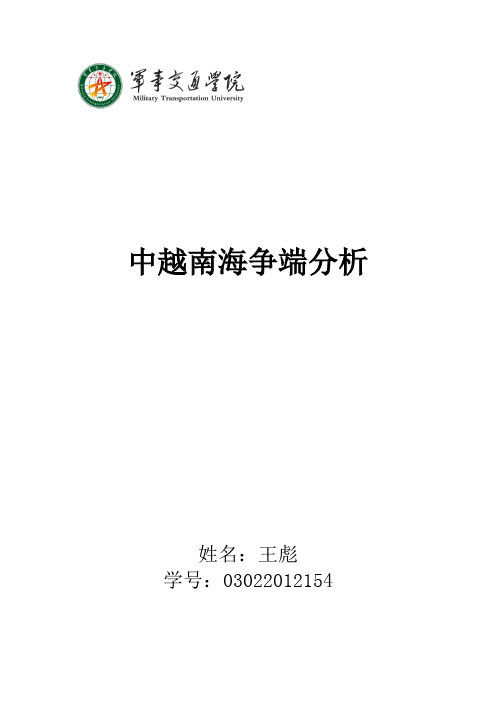
中越南海争端分析姓名:王彪学号:03022012154中越南海争端分析一、中越南海争端现状时事政治教育—南海局势:首先,我们来观看一段关于南海局势的视频。
本次南海争端始末南海争端愈演愈烈,这段时间大家都在关注这个事件,现在根据网上一些资料,我稍微整理了一下,与大家一同回顾事件的始末:5月27日,起因中国三艘海监船驱逐越南探测船平明二号,向其警告侵犯中国海域,并切断其探测缆索。
越南指责中国侵犯其主权。
5月28日,中方回应:正常执法外交部:中方主管部门采取的行动,完全是在中方管辖海域进行的正常海洋执法监察活动。
5月29日,越南外交部越南外交部召开新闻发布会,指责中国加剧区内紧张,发言人在记者会上,扬言“越南海军将采取一切必要措施”保护越南利益。
6月3日,越南黑客发起网络攻击中国国内多家地方政府网站遭黑客攻击,被入侵网站标有“越南黑客是第一”,“越南人民愿意牺牲来保护海洋,天空和国家”等挑衅言论。
6月4日,中国黑客向越南发动反击中国红客联盟6月4日-6月5日反击越南战绩公布,本次反击越南网站:共约1000站点以上,其中红客联盟攻陷站点数在300以上。
红盟作战3厅(新手组),攻击越南最大搜索引擎,导致该站点长达十二小时无法正常访问。
6月5日,越南民众汇集中国使馆抗议数百名越南民众6月5日在中国驻越大使馆门前集会,以抗议所谓的中国船只在南海争议水域“侵犯越南领土”行为。
6月7日,越南民众抗议继续越南民众再次举行大规模游行,声称“抗议中国南海举动”,中越南海争端延烧到民间。
6月7日,中方:主权无可争辩外交部:中国对南海诸岛及其附近海域拥有无可争辩的主权。
希望越方为落实有关共识做出切实努力。
6月8日,中国黑客发动报复性攻击越南外交部等多个网站,怀疑遭黑客攻击,网页出现中国国旗,国歌,和“南沙群岛是中国的”等字样,无法登陆6月9日,局势再度紧张,争端升温越南官方声称,越南国家石油天然气公司的探测船在其200海里专属经济区内进行地震勘察时,遭到中国渔船的冲撞,探测船的钢索被切断。
南海问题分析
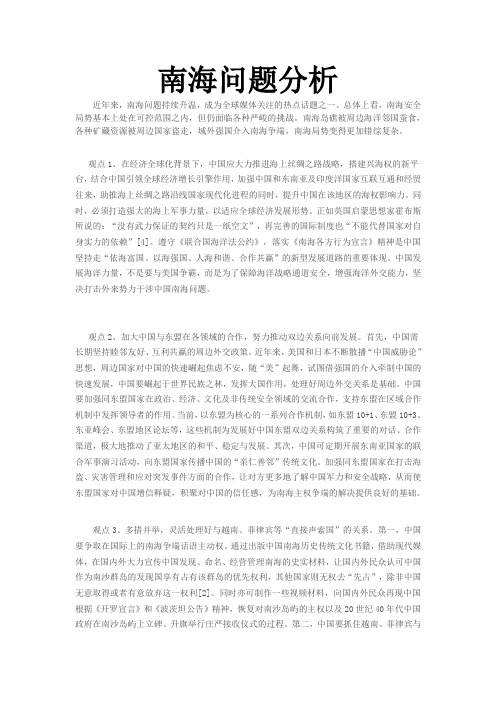
南海问题分析近年来,南海问题持续升温,成为全球媒体关注的热点话题之一。
总体上看,南海安全局势基本上处在可控范围之内,但仍面临各种严峻的挑战。
南海岛礁被周边海洋邻国蚕食,各种矿藏资源被周边国家盗走,域外强国介入南海争端,南海局势变得更加错综复杂。
观点1、在经济全球化背景下,中国应大力推进海上丝绸之路战略,搭建兴海权的新平台,结合中国引领全球经济增长引擎作用,加强中国和东南亚及印度洋国家互联互通和经贸往来,助推海上丝绸之路沿线国家现代化进程的同时,提升中国在该地区的海权影响力。
同时,必须打造强大的海上军事力量,以适应全球经济发展形势。
正如英国启蒙思想家霍布斯所说的:“没有武力保证的契约只是一纸空文”,再完善的国际制度也“不能代替国家对自身实力的依赖”[4]。
遵守《联合国海洋法公约》,落实《南海各方行为宣言》精神是中国坚持走“依海富国、以海强国、人海和谐、合作共赢”的新型发展道路的重要体现。
中国发展海洋力量,不是要与美国争霸,而是为了保障海洋战略通道安全,增强海洋外交能力,坚决打击外来势力干涉中国南海问题。
观点2、加大中国与东盟在各领域的合作,努力推动双边关系向前发展。
首先,中国需长期坚持睦邻友好、互利共赢的周边外交政策。
近年来,美国和日本不断散播“中国威胁论”思想,周边国家对中国的快速崛起焦虑不安,随“美”起舞,试图借强国的介入牵制中国的快速发展,中国要崛起于世界民族之林,发挥大国作用,处理好周边外交关系是基础。
中国要加强同东盟国家在政治、经济、文化及非传统安全领域的交流合作,支持东盟在区域合作机制中发挥领导者的作用。
当前,以东盟为核心的一系列合作机制,如东盟10+1、东盟10+3、东亚峰会、东盟地区论坛等,这些机制为发展好中国东盟双边关系构筑了重要的对话、合作渠道,极大地推动了亚太地区的和平、稳定与发展。
其次,中国可定期开展东南亚国家的联合军事演习活动,向东盟国家传播中国的“亲仁善邻”传统文化。
加强同东盟国家在打击海盗、灾害管理和应对突发事件方面的合作,让对方更多地了解中国军力和安全战略,从而使东盟国家对中国增信释疑,积聚对中国的信任感,为南海主权争端的解决提供良好的基础。
东海问题、南海问题的威胁分析

东海问题、南海问题的威胁分析第一篇:东海问题、南海问题的威胁分析南海问题威胁分析一、南海地区安全环境面临的挑战南海地区处于太平洋到印度洋的中枢位置,具有十分重要的战略地位,其自然资源也非常丰富。
历来为列强所垂涎,现在仍是各大国竞相争取的对象。
在既竞争又合作,合作中也有激烈斗争的形势下,中国在南海方向的安全环境确实有了很大改善,但海上安全仍面临诸多挑战。
1.东盟公开表示欢迎美国的军事力量留在南海地区。
东盟中的越、菲、马、印尼、文莱等国侵占了中国南沙群岛的岛礁和海域,其加强与诸大国的军事联系的意图明显是为了对付中国。
2.美国在南海地区的利益趋势他介入该地区,并保持了一定的军事存在。
3.南海地区被日本视为传统的势力范围。
4.在该地区的政治、经济和军事影响逐步增强,为卷土重来作准备。
二、南海地区的防备策略以长期的战略眼光看,中国政府提出的“搁置争议、共同开发”仍然适用,但在南海严峻的局势下,只有采取多种方式,如对南海争议海域和岛屿实行行政管理、经济开发、科研调查、文化传播、旅游开发,等等。
强化中国在争议海域的存在,才可以在政治、法律、外交解决中赢得主动,才能够遏制被蚕食的现状。
东海问题威胁分析一、东海地区安全环境面临的挑战1.东海位于中国、日本、韩国之间。
日本与中国是相向不共架国,中国大陆架一直延伸到冲绳海槽。
冲绳海槽形成西部大陆架和东部岛架的天然分界。
近年来日本不断就中国进行正常的海洋科考活动和在本无争议的海域进行油气田开发提出抗议和交涉。
2.日本企图将钓鱼岛“国有”,并不断采取措施加强对钓鱼岛海域的实际控制。
3.台湾在钓鱼岛问题上与大陆不在统一战线。
二、东海问题的防备策略东海问题关乎领土主权、海洋权益和海上安全,彻底解决尚待时日。
当前,中日应维持东海问题磋商机制,冷静理性看待分歧,巩固已取得的成果,先易后难,逐步推进,寻求双方均可接受的可实现双赢。
惟有搁置争议,谋求共同开发,方可实现双赢。
中日在东海除资源勘探开发的合作外,还应谋求其他领域的合作可能和共同利益。
- 1、下载文档前请自行甄别文档内容的完整性,平台不提供额外的编辑、内容补充、找答案等附加服务。
- 2、"仅部分预览"的文档,不可在线预览部分如存在完整性等问题,可反馈申请退款(可完整预览的文档不适用该条件!)。
- 3、如文档侵犯您的权益,请联系客服反馈,我们会尽快为您处理(人工客服工作时间:9:00-18:30)。
Financial sector
• Foreign Capital Inducement Law • control private sector’s access to foreign capital • business activities were directed by the state
• South Korea: US$1.64 trillion (12on (20th)
• GDP growth rate 2010-2012
• South Korea: 6.3%, 3.6%, 2%
• Taiwan: 10.8%, 4.1%, 1.3%
South Korea and Taiwan
• development becomes state’s priority • commitment to private property & market • government’s strategic industrial policy • state agencies formulate and implement strategic policies (e.g. Japan’s MITI) • sound macroeconomic management • bureaucratic autonomy from interest groups
Heavy Chemical Industrialization
• HCI plan in 1970s • heavy and capital-intensive industries • strengthening of state intervention • foundation for the emergence of chaebol • combined net sales of the top 10 chaebol • 1974 15.1% of GNP • 1978 30.1% of GNP • 1981 55.7% of GNP
Growth-first goal
• Low interest rate to induce firms to grow • favored large firms • firms compliant with state policies and plans • excessive demand for capital • inflation favored large debtors • inflation discouraged domestic savings • reliance on foreign debts • vulnerable to external shocks
NIE development models
• Singapore, Hong Kong, Taiwan, and South Korea • export-oriented industrialization • state guidance • state involvement in economic development • high investment in human capital formation
South Korea and Taiwan
• Military strongman rule from 1960s to 1970s • South Korea • Park Chung Hee (1962-79) • Taiwan • Chiang Kai-Shek (1945-75)
Park Chung Hee
Comparison
• Population
• South Korea:49 million
• Taiwan:
23 million
• land area
• South Korea:96,920 km2
• Taiwan:
32,260 km2
South Korea and Taiwan
• Purchasing power parity GDP of 2012
South Korea's GNP & Export Growth Rates (% ) 100
80
60
40
20
0
-20 1962 1963 1964 1965 1966 1967 1968 1969 1970 1971 1972 1973 1974 1975 1976 1977 1978 1979 1980
NIE development model dead?
• South Korea in 1997 • negative growth for the 1st time in 2 decades • unemployment rate rose from 3% to 7% • per capita GNP almost shrank by half • Taiwan in 1997 • economic growth slowed down • still robust • Is the NIE development model in crisis?
GNP Growth
Export Growth
Financial sector
• Government owned and controlled • all 5 commercial banks • including the central bank (Bank of Korea) • all 6 special banks • 2 of the 3 non-bank financial institutions
